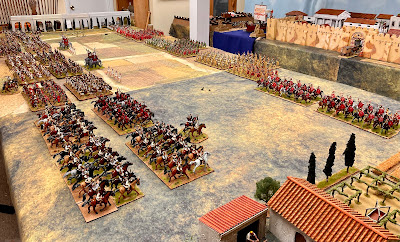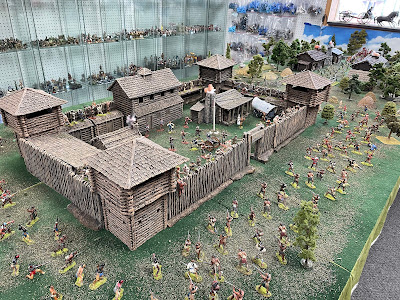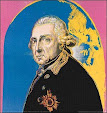 |
| Napoleonic Peninsula War terrain on my table top |
Click on all pictures to enlarge
Recently I stumbled across an interesting topic about terrain on the You Tube video blog:
Big Lee's Miniature Adventures Vpblog
Click this link to Big Lee's You Tube page (and click the subscribe button on his page) and have a listen. It only takes about 12 minutes and is worth the listen to this thoughtful presentation. Big Lee addresses the question "How Much Terrain Is Enough Terrain?" and it is something that I do not always think about because some of the elements of building a movie set on my game table are intuitive because I have been doing them for so long that set design becomes second nature to me.
Here are some of the topics that Big Lee covers. The comments are my own, not Lee's:
(1) How much terrain is enough on a war games table?
--- club game versus a big demo game: the big games tend to have more detailed terrain for the simple matter that we have more tabletop space to work with at a convention game. At the home/club level we are happy to get away with a little bit less which improves the playability of the game.
---- more always looks better: this is my philosophy for the most part. You can never have too many trees on a wargame table.
--- terrain as set dressing: Thanks to Big Lee, I have now started to think of myself as a movie producer and director rather than a host of a wargame at a convention. I like to view my table as the set of a big budget movie. I have to write a script (the game scenario), create game objectives (the story plot), be a casting director (collect, paint and provide the figures used in my game), and design the movie set (the game table).
--- game play/playability this is probably the most important thing to consider before you set up your table top terrain. A Hollywood quality (railroad setup) terrain looks good, but it can lead to a bad game if the terrain hinders the players from actually playing the game. Do you really need to have that large woods in the center of the table, or can it serve its purpose better if the woods is set up along the edge of the table? Is that river down the middle of the table going to impede the play of the game or can you tilt your tabletop 45-degrees and move the river out of the center? If you are going to use a large mass of buildings, perhaps it would be better to set up the game as a skirmish game that takes place in the city. Can you shift some of your terrain pieces to the left or right that will create larger avenues for troop movement?
(2) Aesthetics
--- we all want to put on a good show: very true. I tend to go overboard on the vignettes and the little details as a way to display my sense of humor and convey to the players that this is not life or death, but simply a game.
--- pride of your collection and artistry: I admit that I like to 'show off' when it comes to setting the tabletop for a convention game. Conventions usually give me more tabletop acreage to display my figures and terrain pieces in a larger way than I can in the smaller confines of my Man Cave tabletop. A convention game always nags at me to add a little something more.
 |
(3) Balance too little versus too much
This is always the overarching decision to make when you are bringing your scenario to life as a three dimensional tabletop game. I find that if I have enough open avenues for troop movement then the game will flow much better and my gamers will enjoy a better playing experience. Then they will come back next year and seek out my game and play in it.
The picture below, of my Hannibal game at home, shows the need for plenty of wide open space to move these large 54mm toy soldiers. A lot of terrain pieces in the middle of the table between the battle lines would hinder the play of the game.
 |
(4) Realism balanced with playability
The longer that I have been in the hobby the more I want to do to make my terrain better. Many of my readers would say that I am already doing a pretty good job of it. But I feel that there is always room for improvement. The picture below shows one of my Seven Years War 28mm game set ups. There is plenty of realism when viewed from afar, and even more if one stoops down to table top level and views the terrain from the ground level. However, you will note that the center of the table provides plenty of room for game players to move their troops without running into difficult terrain. The left side of the picture has more terrain obstacles than the center, but even then, there are definite avenues of approach in those areas. I think that this picture illustrates a nice balance of realism with playability.
(5) Size of the table and scale determine what you need
This is not a big consideration for me because I have the good fortune to having a basement that can accommodate two parallel tables measuring 6ft by 12ft. For even larger games, I have a friend who has three gigantic 6ft by 32ft tables, parallel to each other, that we can use when we want to really go crazy on epic level wargames.
(6) Decorative versus Functional terrain
--- little items that have no in game effect but look good. As Big Lee says, we have to make our own judgement of what terrain is merely for decorative purposes and what we really must have (at a minimum) in the terrain to match up with the game. The picture of the Roman ship in port was something that I messed around with at home for the fun of it, but it did not become a part of my Hannibal game terrain for the simple reason that there was no need for it and I'd rather spend my tabletop space on open areas for the playing of the game. Looks great, but not very functional.
Not very useful terrain. It looks good, but is not really functional for my game.
(7) Does too much terrain slow down the game?
---- filling up the table with terrain without regard to movement. Yes this can be a problem, but once you have had the experience of playing in a game where the amount of terrain ruined a good time, then you likely won't allow it to happen again. Sure, I could set up a railroad display that would look fantastic, but the logistics of transporting such a game to a convention would stop me from attempting such a thing.
(8) One Third Rule? (only one third of table should be covered with terrain)
---- treat this as a starting point and then modify to fit your scenario. I had not heard of the One Third Rule prior to listening to Big Lee's pod cast. It does make intuitive sense and I have probably been setting up my game tables this way without even knowing it. Going forward I will be more cognizant of the amount of terrain that I place on my table.
---- think like a photographer or set designer; what tells the story of the battle : this is really a good piece of advice and this is probably my number one take away from Big Lee. The game needs to tell a story. I can improve my convention games by giving more thought to the story that I am trying to tell in my game. Below, here is someone who is one of the convention greats at telling a story with his games.
---- terrain that looks good and is functional: this goes back to our previous comments about the functionality of terrain. You have hit the jackpot if you can achieve both good and functional.
"Good terrain placed thoughtfully makes a big difference with your participating players" - Big Lee
 |
| 54mm French & Indian War stockade fort at the Gettysburg Toy Soldier store. |
 |
| Cityscape for a small skirmish game. This fits on a 6ft by 5ft table. |
 |
| A recent AWI game in my Man Cave. Lots of open area for maneuvering, but sufficient terrain pieces to tell the story. |
 |
| AWI terrain depicts a small farm on the edge of civilization. The pair of farmers working in the field tell their own story, yet their placement on the table does not interfere with the game. |
 |
| The same AWI terrain as shown in the previous picture. I think that lots and lots of trees can never look wrong on a game table. If you think that you have enough trees then get even more of them. |
 |
| ACW terrain for 54mm figures from my Antietam war game. Snake rail fences and lots of trees are essential to ACW games. |
 |
| I like to take "ground level" photos of my table top sets. They add a degree of realism to the photo. This is one of my favorite pictures. |
 |
| Same scene as the previous picture, but not quite as effective when the photo is snapped from a higher level than ground level. |
 |
| Individual vignettes are usually placed in the four corners of my table set ups. This is where you can have some fun with your creativity. |
 |
| Again, another built up area is placed in one of the corners of the table. There could be some fighting here, but it won't determine the outcome of the game. |
ccc









Wow! I’m gobsmacked that this post hasn’t generated ANY conversation. I consider this to be one of the top ten blog posts that I have ever created. 😢
ReplyDeleteHate to see you gobsmacked, so allow me to comment. I live in a remote area, so no clubs or anything like that - strictly solo. I play ancients, medieval, some fantasy and WWII. For me it depends on the era. So lots for WWII skirmish, not so much for Punic Wars.
DeleteI too play more solo games than multiplayer games these days so I can use a more terrain intense tabletop. Nevertheless, I still stick by my basic principles of terrain setup, leaving distinct open areas for the majority of the fighting. In skirmish level games I find it easier for small forces to send their way through more difficult terrain.
DeleteDon't be gobsmacked- there is a lot to absorb and ponder! It's a great post and your terrain in every scale looks amazing. For me mass battles means limited terrain to allow troops to manoeuvre. It can be very frustrating to be playing the wing of an army with 20 or 30 squadrons of horse...and not be able to move them because of the hills/farms/woods/citywalls/vignettes.The balance needs to be right to move unit bases that have anywhere from 3 to 12 figures on them. This gives scope to be able to have the game flow. If it is an historical scenario, then the table size should allow teh armies to move in the manner and in relation to the terrain that they did historically. Image Ney's charge on the table being blocked by several woods? But when it is a skirmish style game with every figure based individually then the attraction is a literal 'flood' of terrain. It is what makes the game more absorbing and fun. In this case- the more terrain the better.
ReplyDeleteMass battles with less terrain speaks to the playability element of the game and I agree with your point. I can recall one SYW game I played that featured a huge Forest in the middle of the table and a minimal amount of open space on the flanks. We played about two turns and found the scenario unplayable relative to the types of troops at our disposal. We stopped the game and reset the terrain into something more playable.
DeleteI think that playability should always be the first consideration when it comes to setting up one’s terrain.
I have found that many historical battles do not make for a good wargame.
ReplyDelete